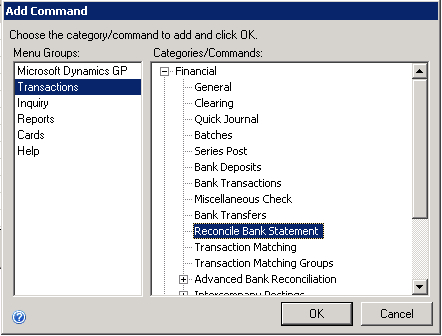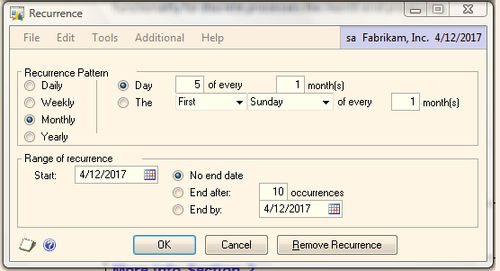Dynamics GP provides a Task List for managing items
to be accomplished within the system. Although it is not quite as
powerful as say Outlook's tasks, the Task List in Dynamics GP can
provide direct links to the appropriate window, web page, or external
file needed to accomplish a task. Even Outlook can't provide a direct
link to the right window in Dynamics GP. Additionally, tasks can be
assigned to other users in the system to better delegate the workload.
In this recipe, let's look at how to use the Task List in Dynamics GP.
Getting ready
Open tasks are displayed on the Home page in Dynamics GP under the To Do heading.
To get started, select New Task
from the Home page to see the full task list. An example is shown in
the following screenshot. Yes, that's not particularly intuitive, but
that is how it works:

How to do it...
As an example, we'll look at adding a month-end bank reconciliation task by completing the following steps:
1. To create a new task, select New Task from the To Do section on the Home page to open the full task list.
2. Select New Task on the Task List window. In the Task field, enter Reconcile Bank Statement. Set the due date to the 5th of May and the Status to Pending:

3. From the Task Assigned To drop-down menu select a user to assign this task to. From the Link To drop-down menu select Microsoft Dynamics GP window.
4. To attach the Reconcile Bank Statement window, click on the blue arrow next to the Name field.
5. In the new Add Command window that opens select Transactions on the left. Then click on the plus (+) sign next to Financial on the right.
6. In the right-hand side pane select Reconcile Bank Statement and click on OK:

7. Click on Save to save the task. If the task was assigned to another user it will now appear in their task list.
How it works...
The new task now appears in the Tasks
area on the Home page. Selecting the checkbox next to a task marks it
as complete and sets the user who completed the task as well as the date
the task was marked as completed.

There's more...
Even better, tasks can be
repeated. This means that they work great for regular processes such as
month-end or quarter-end tasks.
Recurring tasks
To set a task as recurring:
1. Select the Recurrence button during task creation or double-click on an existing task and select Recurrence.
2. From the previous example select the Reconcile Bank Statement task and double-click on the line.
3. Click on the Recurrence button. Set the Recurrence Pattern to Monthly on Day 5 of every 1 month. This means the task will recur on the 5th of every month. That's about five days after a typical bank statement cutoff.
4. Leave the Range of recurrence set to No End Date and click on OK.
Now
this task will repeat on the 5th day of every month, perfect for a
calendar month-end bank cutoff. Obviously, if a company's bank statement
cuts off at some other time during the month these settings can be
easily changed:
